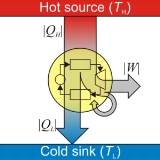can a heat engine attain the eficiency of a carnot engine?
replied to: anju28
Replied to: can a heat engine attain the eficiency of a carnot engine?...
No,as carnot engine is hypothetical
replied to: keshabananda
Replied to: No,as carnot engine is hypothetical
Sadi Carnot described an engine in his book "reflect on the motive power of fire." The disadvantage of its construction is the fact that it offers a moving heat source while Robert Stirling built an engine in which heat sources are fixed and gas moves between the two sources to the aid of a mover. (Except for the engine Alpha). Both engines have in common four cycles of transformations: isothermal and adiabatic (Carnot) and isothermal and isochoric ( Stirling).
The Carnot engine was reported as impossible to builtvery early "This cycle is theoretically impossible, since the perfect adiabatic and perfect isothermal are impossible to obtain." Steam engine and various heat engines J. Dejust (1899) "). Who speaks perfect engine? The Stirling engine and Ericsson engine are they perfect?. The best imperfect of hot air engines is the Carnot engine because it does not require a regenerator, the main imperfection Stirling engine (dead volume vs. efficiency). There are many architectures to held the Carnot cycle. here's one here:
thecarnotengine.blogspot.com Make this architecture and you have the hot-air engine the least imperfect.
I was told it would be less powerful than a Stirling equal size. Not true! Heat transfer occurring in isothermal processes that are the same on both engines (with T.hot and T.cold identical and identical mass of the same gas). The best of both is the one with the least amount of dead volumes; Carnot!. It was not done because no one had seriously thought.
The discussion is now open.

